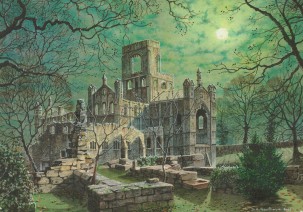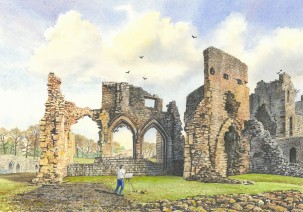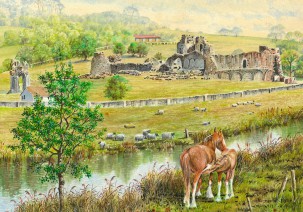Welcome to the Abbey’s of Yorkshire
Richard has exhibited at both the British Watercolour Society and the British Society of Painters in the last twenty five years and became Chairman of the Selection Committee for both sociteties.
Yorkshire and it’s beautiful abbeys have inspired and attracted countless visitors over the last 800 plus years. Monuments to the monks building prowess and set in glorious Yorkshire countryside, they have inspired Richard Gawthorpe, one of Britains finest watercolourist to paint a series covering all ten abbeys in Yorkshire.
We can offer high quality prints of all ten abbeys on the finest cold-press rough textured art paper which makes the finished picture virtually indistinguishable from its original.
For further authenticity all prints will be signed by Richard Gawthorpe. When framed they will enhance any room and perhaps bring back happy memories of visits made.
We have a full selection of Yorkshires most admired abbeys in stunning watercolour print listed below. You can view all our prints by visiting our GALLERY PAGE.
Kirkstall Abbey is a ruined Cistercian monastery in Kirkstall north-west of Leeds city centre in West Yorkshire, England. It is set in a public park on the north bank of the River Aire. It was founded c.1152. It was disestablished during the Dissolution of the Monasteries under the auspices of Henry VIII. Kirkstall Abbey was acquired by Leeds Corporation as a gift from Colonel North and opened to the public in the late 19th century. The gatehouse became a museum.
Easby Abbey or the Abbey of St Agatha is an abandoned Premonstratensian abbey on the eastern bank of the River Swale on the outskirts of Richmond. The site is maintained by English Heritage and can be reached by a riverside walk from Richmond Castle. The Abbey of St. Agatha, Easby, was founded in 1152 by Roald, Constable of Richmond Castle. The inhabitants were canons rather than monks.
The ruins of Kirkham Priory are situated on the banks of the River Derwent, at Kirkham, North Yorkshire, England. The Augustinian priory was founded in the 1120s by Walter l’Espec, lord of nearby Helmsley, who also built Rievaulx Abbey. Legend has it that Kirkham was founded in remembrance of l’Espec’s only son who had died nearby as a consequence of his horse being startled by a boar. The area was later used to test the D-Day landing vehicles, and was visited by Winston Churchill. The ruins are now Grade I listed and in the care of English Heritage.
Whitby Abbey is a ruined Benedictine abbey overlooking the North Sea on the East Cliff above Whitby in North Yorkshire, England. It was disestablished during the Dissolution of the Monasteries under the auspices of Henry VIII. It is a Grade I Listed building in the care of English Heritage and its site museum is housed in Cholmley House. The first monastery was founded in 657 AD by the Anglo-Saxon era King of Northumbria, Oswy (Oswiu) as Streoneshalh (the older name for Whitby).
Selby Abbey is an Anglican parish church in the town of Selby, North Yorkshire, England. It is one of the relatively few surviving abbey churches of the medieval period. Like York Minster, the church rests on a base of sand and has suffered from subsidence. Many sections collapsed entirely during the 17th century, and further serious damage was done by a fire of 1906 which melted the bells in the central tower. Nevertheless, extensive rebuilding and refurbishment has made the church one of the most impressive in the country.
Rievaulx Abbey is a former Cistercian Abbey in Rievaulx. Headed by the Abbot of Rievaulx, it was one of the wealthiest abbeys in England until it was dissolved by Henry VIII. Rievaulx Abbey was founded in 1132 by twelve monks from Clairvaux Abbey as a mission for the colonisation of the north of England and Scotland. It was the first Cistercian abbey in the north. With time it became one of the great Cistercian abbeys in Yorkshire, second only to Fountains Abbey in fame.
Jervaulx Abbey in East Witton near the city of Ripon, was one of the great Cistercian abbeys in Yorkshire, England, founded in 1156. Initially a Savigniac foundation, the abbey was later taken over by the Cistercian order and responsibility for it was taken by Byland Abbey. Originally founded in 1145 at Fors in Wensleydale, it was moved ten years later to a site a few miles away on the banks of the River Ure. It was dissolved in 1537, and its last abbot Adam Sedbar was hanged for his part in the Pilgrimage of Grace.
Byland Abbey is a ruined abbey and a small village in the Ryedale district of North Yorkshire, It was founded as a Savigniac abbey in January 1135. It wasn’t an easy start for the community who had had to move five times before settling at New Byland, near Coxwold in 1177. Its early history was marked by disputeswith no fewer than four other religious establishments: (Furness Abbey, Calder Abbey, Rievaulx Abbey and Newburgh Priory).
Bolton Abbey is an estate in Wharfedale in North Yorkshire, England, which takes its name from the ruined 12th-century Augustinian monastery. The monastery was originally founded at Embsay in 1120. Led by a prior, Bolton Abbey was technically a priory, despite its name. It was founded in 1154 by the Augustinian order, on the banks of the River Wharfe.
Fountains Abbey is one of the largest and best preserved ruined Cistercian monasteries in England. It is located approximately three miles south-west of Ripon in North Yorkshire. Founded in 1132, the abbey operated for over 400 years, until 1539, when Henry VIII ordered the Dissolution of the Monasteries. After a dispute and riot in 1132 at the Benedictine house of St Mary’s Abbey, in York, 13 monks were expelled (among them Saint Robert of Newminster) and, after unsuccessfully attempting to return to the early 6th-century Rule of St Benedict, were taken into the protection of Thurstan, Archbishop of York.

Kirkstall Abbey is a ruined Cistercian monastery in Kirkstall north-west of Leeds city centre in West Yorkshire, England.
£2 donated to Kirkwood Hospice for every 12″ x 9″ print purchased.
| 12″ x 9″ Print (signed by Richard Gawthorpe) | £29.95 |
| 7″ x 5″ Print | £2.50 |
| Pack of all 10 7″ x 5″ Prints | Click Here |

Easby Abbey or the Abbey of St Agatha is an abandoned Premonstratensian abbey on the eastern bank of the River Swale on the outskirts of Richmond.
£2 donated to Kirkwood Hospice for every 12″ x 9″ print purchased.
| 12″ x 9″ Print (signed by Richard Gawthorpe) | £29.95 |
| 7″ x 5″ Print | £2.50 |
| Pack of all 10 7″ x 5″ Prints | Click Here |

The ruins of Kirkham Priory are situated on the banks of the River Derwent, at Kirkham, North Yorkshire, England.
£2 donated to Kirkwood Hospice for every 12″ x 9″ print purchased.
| 12″ x 9″ Print (signed by Richard Gawthorpe) | £29.95 |
| 7″ x 5″ Print | £2.50 |
| Pack of all 10 7″ x 5″ Prints | Click Here |